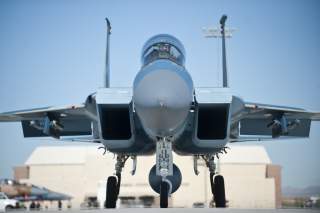Why the Air Force (As In the F-22 and F-35) Needs Boeing's F-15X Fighter
Unfortunately, today’s fighter force mix, despite increasing numbers of F-35s over time and upgraded F-22s, will likely not be enough to meet future needs. America needs the F-15X.
America depends on airpower. Airpower underpins the military options leaders use to enhance deterrence and if deterrence fails, to fight and win with minimum casualties.
A key element of America’s airpower is the fighter force. Historically, fighter aircraft development has shaped militaries and tactics like no other combat system. Today’s emerging technologies, concepts of operations (CONOPs), and tactics, techniques and procedures (TTPs) have increased fighter effectiveness to extraordinary levels.
The U.S. Air Force flies a mix of 4th and 5th “generation” fighters. The 4th gen F-15, F-16 and A-10 fleet is very capable and continues to be the backbone of today’s force. Fourth gen fighters fill the majority of the combatant commander (COCOM) taskings including homeland air defense alert and expeditionary taskings worldwide. The smaller fleet of 5th gen fighters are “low density/high demand” with 187 F-22s and 150+ F-35s. Stealth and sensor fusion technologies make them the most lethal and survivable fighters in the world. The Air Force intends to continue procuring 48+ F-35s per year and upgrading the F-22. Up to this point, the complementary mix of a small but stealthy 5th gen fleet combined with a large fleet of very capable 4thgen fighters has proven adequate in meeting today’s warfighting needs.
Unfortunately, today’s fighter force mix, despite increasing numbers of F-35s over time and upgraded F-22s, will likely not be enough to meet future needs. Specifically:
- Current operations tempo for the entire fighter fleet remains high without any relief in sight.
- Future fighter availability will be reduced or restricted due to needed upgrades, including the F-22 and early models of the F-35.
- 4thgen maintenance and operating costs continue to climb, and upgrades are costly, time-consuming and potentially cost may prohibitive.
- Adversaries continue to invest in technologies designed to find, fix, target and engage 5thgen fighters. This will minimize and could totally deny the asymmetric advantages we have today.
- 5thgen weapons internal weapons load capacity is limited.
- 5thgen procurement will continue to be constrained by production and budget limitations, particularly in the short term.
- 5thgen cost per flying hour (CPFH) is significantly higher than the F-15X, and CPFH for 4th gen fleet is increasing significantly as they get older.
One clear solution to mitigate these challenges is the immediate introduction of Boeing’s F-15X into the current fighter force. While DoD was focused on getting the F-35 IOC and increasing inventory, Boeing continued to improve the capability and capacity of one of the most successful fighters in history. The F-15X is a 4th gen ++ fighter that will significantly complement the capabilities of the current fighter force with better sensors, more weapons capacity, reliable data links, and extended range. In addition, the F-15X will provide relief to the 5th gen fleet from missions that do not require stealth but require advanced sensors, weapons, datalinks, and range to optimize effectiveness and survivability.
The F-15X is the common-sense answer to the limitations of both the current and future fighter force. Ten specific reasons include:
- It is immediately available, affordable and sustainable without additional training for aircrews and maintenance personnel.
- It is an aircraft with a combat-proven track record and an incredible 20,000-hour airframe life.
- It can deliver more weapons to any fight because it is not restricted by the number of hardpoints available in constrained 5thgen fighter weapon bays.
- The bed down will not require significant infrastructure improvements or new ground support equipment.
- The F-15X mission computer can instantaneously process and pass data on the Link 16 data link. This robust capability degrades the effects of ever-increasing adversary threat spoofing and jamming. In addition, it can readily integrate, share and extend the Link 16 network to other US, coalition and partner fighters. The F-35 has Link 16 capability, the F-22 has an aircraft-specific data link.
- The F-15X EPAWSS (Eagle Passive-Active Warning Survivability System) is an impressive electronic warfare (EW) and integrated countermeasure system (ICS) suite that makes the F-15X more survivable without dedicated assistance to survive. In addition, it can help support the EW tactical game plan of the 5thgen fleet.
- The F-15X will provide needed redundancy and significant additional fighter capability and capacity if adversaries are successful in degrading our current 5thgen advantages and effectiveness.
- F-15X capabilities will significantly expand force mix options, CONOPs, and TTPs for warfighters planning across the full spectrum of military conflict. This will make the enemy’s job even more difficult if not impossible to overcome.
- As a future FMS fighter option, it can help build partnership capacity with allies and partners who do not need, want or cannot afford a 5thgen fighter.
- Retaining another active fighter production line with the F-15X will help sustain a diverse industrial base and provide the needed capacity to defeat great power, near-peer adversaries as described in the National Defense Strategy (NDS)
Adding the F-15X to the current 4th and 5th gen fighter mix is a reasonable and affordable way to ensure the viability and strength of the future fighter force. Many will argue we cannot afford to add another fighter to our current inventory. However, adding the F-15X is really about adding needed capability so that today’s 4th and 5th gen fighter mix is ready to meet future warfighting requirements. Considering the possibility of an existential great power, near-peer conflict with China or Russia as described in the NDS, I say we have no choice.
General Frank Gorenc USAF (Ret.), is a four-star general who served as Commander of Allied Air Command, NATO and U.S. Air Forces in Europe.
This first appeared in RealClearDefense here.


